Making correct decisions is a crucial skill at every level while choosing the right SEO tutorial. The most important thing in the process is comprehending what you precisely know about SEO and what SEO actually is. This post is composed of that order and will help you do the very thing.
According to Search Engine Journal, over 35% of revenue is captured by organic traffic.
These stats are proof that Search Engine Optimization is one of the core components of Digital Marketing.
Good SEO work only gets better over time. It only searches engine tricks that need to keep changing when the ranking algorithms change. – Jill Whalen
Let’s begin with understanding the basics of SEO.
What is SEO?
SEO or Search Engine Optimization is actually a subset of Search Engine Marketing that is all about optimizing a website or webpage for search engines. SEO is useful for:
(i) Designing and developing a website that is Search Engine Friendly.
(ii) Optimizing the volume and quality of website traffic from search engines.
(ii) Knowing how search algorithms work and what your target audiences might search.
This SEO Tutorial includes guidelines that help you know how to optimize web pages or whole sites in order to make them search engine friendly that ensures better positions in SERPs.
It will explain simple SEO techniques that optimize the visibility of your online business for different search engines such as Google, Bing, and Yahoo.
It will further help beginners understand effective SEO characteristics while informing professionals about the latest SEO trends and algorithm updates to optimize their SEO campaigns.
Complete SEO Tutorial to Learn SEO Basics
To understand the SEO basics, it is a must to go through the below-mentioned steps involved in optimizing a website or a webpage so that professionals can learn SEO for a new website in the easiest possible manner.
1. Choosing SEO Friendly Website Domain
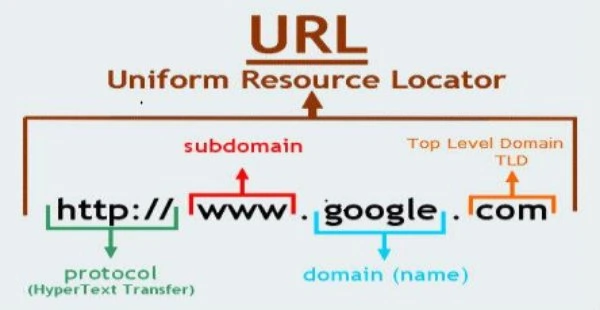
The first thing that you need to do when starting an E-business is thinking about your website domain name. Before choosing a domain, you need to consider the following things:
(i) Your target audience.
(ii) What you want to sell to them: Something relevant to the item or content?
(iii) What makes your online business unique?
(iv) Use of keywords in the domain.
(v) Avoid going for long and confusing domain names.
(vi) The use of the domain name that is catchy, relevant, and memorable.
2. Knowing SEO Tactics and Methods
The SEO basic techniques are classified into two broad categories:
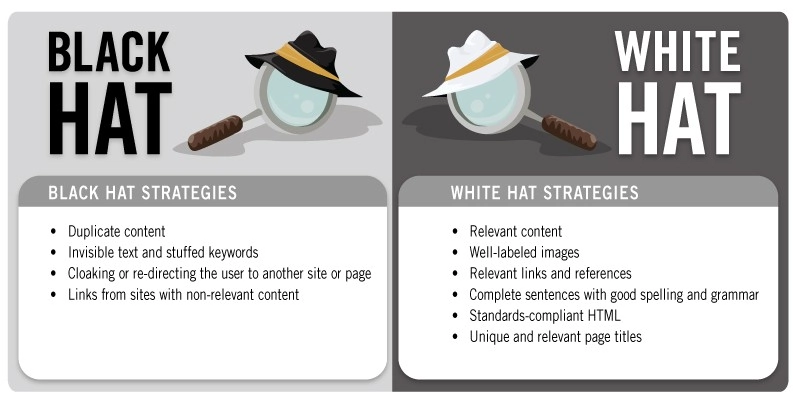
(A) White Hat SEO
These are the techniques that search engines approve of. It is a must to follow white hat SEO tactics and you should never try to fool your visitors. White hat SEO techniques include:
(i) Following search engine’s guidelines and not using any deception.
(ii) It lets the user see the same content that search engine indexes and ranks meaning that there is no deception.
(iii) It means your content is user-focused and not just meant to increase search ranking.
(iv) Ensuring that the quality of the web pages is good and useful under White Hat SEO practice.
(B) Black Hat SEO
SEO technique that is not approved of by the search engines is termed as Black Hat SEO or spamdexing. Search engines can easily identify Black Hat SEO practices which will impede you from getting any benefits. Black Hat SEO practices include:
(i) SEO practices that involve deception and are disapproved by the search engines.
(ii) Redirecting users to human-friendly pages from search engine friendly pages or redirecting users to any page which is different from the page which was earlier ranked by the search engine.
(iii) Using cloaking SEO in which one version of the page is served to search engine spiders/bots and another version is served to human visitors.
(iv) Employing meta tag stuffing in which keywords are repeated in meta tags but the content is not related to those keywords.
(v) Employing keyword stuffing in which keywords are placed in a calculated manner in a content.
(vi) Using Doorway or Gateway pages in which low-quality web pages contain very little content which is stuffed with the same kinds of keywords and phrases.
(vii) Using mirror websites in which multiple websites or different URLs use conceptually similar content.
(viii) Incorporating Page Hijacking practices.
3. Use of SEO friendly Design & Layout
You should never make your site too complicated, as it is important that the search engine easily parse the content of your site and index them without any difficulty.
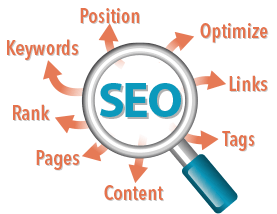
Here are a few important points to keep in mind when designing a web page:
(i) Having more text content than HTML elements is beneficial since users look for relevant content above anything.
(ii) Avoid frames as Search Engines and Frames are enemies of each other. Many users find it difficult to navigate within frames because frames are confusing to the user and the search engine.
(iii) Ads too should not be used because most of the ads use JavaScript. The drop-down menus in JavaScript prevent web spiders from crawling beyond the home page. If you do use ads, add text links at the bottom of the page.
(iv) The page topic should be related to your content. Only put those things in the page-topic that fit appropriately.
(v) Do not include unnecessary directories.
(vi) Avoid fancy additions like animations and GIFs unless absolutely essential since these affect indexing.
4. Optimization of Keywords, Meta Tags, Title & Anchor
(A) Optimization of Keywords
Optimizing keywords is an important consideration in any SEO tutorial. The right keyword represents your website perfectly and improves your search ranking. A keyword phrase is just as important. This phrase has 3-5 words and is specific to your site.
Focusing on the following things will help optimize your keywords:
(i) Keyword Frequency
This measures how often the keyword appears on your website. Websites need to maintain optimum keyword density to increase their search ranking.
(ii) Keyword Weight
After keyword frequency comes keyword weight, which is the number of keywords that appear in your content. The keyword weight is measured against the total words in your content. When you use fewer keywords, the focus on the relevant keywords increases, helping your search ranking.
(iii) Keyword Placement
The next part of a search engine optimization tutorial is managing the keyword placement. Placing your keyword strategically on the page will help increase relevance.
(iv) Keyword Prominence
Keyword prominence means how high up on a page is your keyword found. It’s always good to have the primary keyword in the first 20 lines of your article.
(v) Keyword Proximity
This means the placement of keywords in relation to each other or with words with similar meaning. When the primary keyword is placed next to its connected phrase, it gives relevant results.
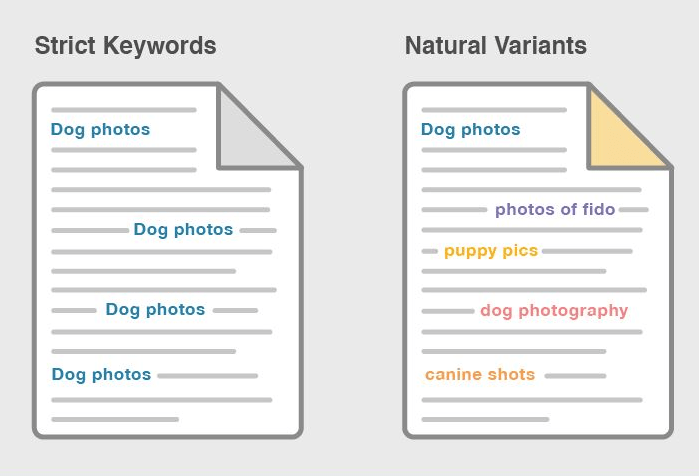
This is where you should use your main keywords-
(i) In <title> tag(s)
(ii) In <meta name=”description”>
(iii) In <meta name=”keyword”>
(iv) In <h1> or other headline tags
(v) In <a href=”https://yourcompany.com”>keywords</a> link tags
(vi) In the body copy
(vii) In alt tags
(viii) In <!– insert comments here> comments tags
(ix) In the URL or website address
(B) Optimization of Meta Tags

While meta description is often displayed as a part of search result, meta tags should not appear with such results. Meta tags are only meant to tag relevant keywords and not form a part of your content.
(i) Meta Description Tag Tips
(a) Use keywords in your Meta description tag and do not repeat the words.
(b) Try to use multiple syntaxes of your keywords.
(c) Meta description of a single web page should not have more than 150 characters.
(d) Each page should have different meta tags.
(II) Meta Keywords Tag Tips
(a) Use synonyms and unique keywords.
(b) You should avoid repeating any given phrase.
(c) Repetition of a word is allowed multiple times if each time it is a part of a different phrase.
(C) Optimization of Title and Anchor Text-
(i) Each web page needs to have a unique title and you should try to include your primary phrase in the title of each page.
(ii) Begin the title of your homepage with the primary keyword phrase, which should be followed by your best secondary keyword phrases.
(iii) Use descriptive anchor text for all your text links. It plays a significant role and is seen by the search engines.
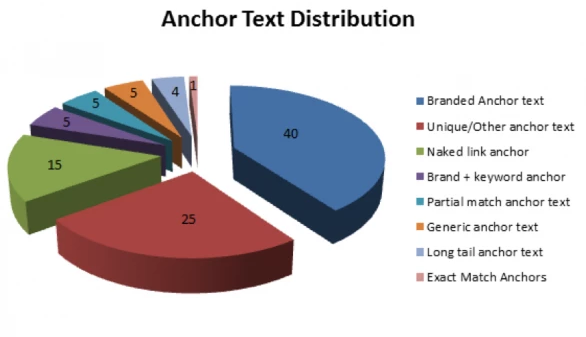
5. Research and Analysis
(A) Keyword Research
The keyword is the most important part of an SEO tutorial since the right keywords can help your website land on the first page of search results. Since you have to compete with so many other websites, using the right keywords is essential. Researching relevant keywords for your content can help you reach your target audience. Once you research your keywords, the next step is analysing the keywords collected by you and picking out the ones most suited to your website and product. This practice also helps you understand your users better.
(B) Competitor Analysis
The next step to keyword research is analyzing competitor websites. Doing so helps you improve your own marketing strategies. There are various analysis tools designed for this purpose, wherein you have to enter your website URL, the competitor URL, and the target keyword and the tool will predict the ranking of your keyword against that of your competitors. Here are some things you can do to analyze your competitor’s website:
(i) The first step is to analyze which websites fall into your niche. To get this result, type your keyword in Google search and the results that are at the top are your competitors.
(ii) If you already have an idea of your competitors, you can visit their website to check the content quality, keywords and phrases used, and type of website. Use this information as a basis to develop your content.
(iii) The last and most important part of research and analysis is checking your competitors’ social media presence. Social media is a popular way of attracting customers, so analyzing the popularity of your competitor’s posts can give you an idea of what your target audience is interested in.
(C) SWOT Analysis
SWOT stands for Strength, Weakness, Opportunity, and Threat and is an important part of any search engine optimization tutorial. SWOT analysis is popularly used to analyze a business’s capability in the market. This analysis can also help to determine the potential of your website.
Swot Analysis is divided into two parts: internal and external factors. Internal factors are those which can be controlled by the marketer, while external factors are those that occur outside the organization and cannot be controlled as easily.
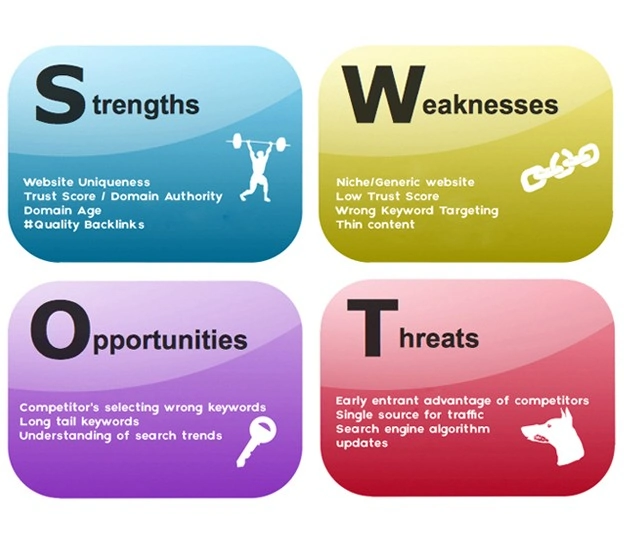
To conduct a SWOT analysis, start by setting a specific and realistic goal for your website. Then, focus on the following steps:
(i) Strength
Think of advantages that you can offer that are not in your competitor’s websites so that your content can gain an advantage over your competitors.
(ii) Weakness
Identify points that slow down your goals. This could be a feature that your competitor performs better than you at.
(iii) Opportunity
These are things on the outside that can help increase your website’s potential. Identify these opportunities and use these to your advantage.
(iv) Threat
Opposite of opportunity; a threat is an external factor that prevents the growth of your website. Software piracy, government regulations, and competition are some common threats that can hinder your website’s progress.
(D) Choosing Your Keywords
Keywords are what enable your website to get ranked on a search engine. The more relevant keywords you use, the more audience you will attract. Below are some points to make your keyword searching more relevant.
(i) Long-tail keywords
These are 3-5 word phrases that are used to target people in the buying stage. The benefit of a long-tail keyword is that they are less competitive and more product-specific, thus helping you target the right audience.
(ii) Semantic indexing
In this type of keyword analysis, related terms are used with primary keywords to make your content more relevant.
(iii) Keyword trends
Study the latest keyword trends to get more traffic to your website. Google Trends is a popular way to find the trends of your keywords.
(iv) Keyword-based on location
To make your keywords more user-specific, add the name of a city or country to your main keyword to make your keyword stand out.
6. Link Building and Mobile SEO
(A) Link Building
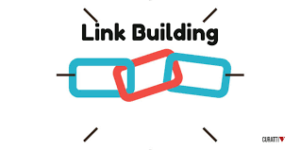
(i) Link building involves obtaining links from external websites to your own for improving direct referrals and search engine ranking.
(ii) Link building boosts your site link popularity, and for ensuring effective link building, you should submit your site in popular search engines manually, as automated submission does not offer any SEO benefit.
(iii) You should list your site in open directory projects and you must use high-quality content. You may also try to use Link Exchange programs.
(B) Mobile SEO
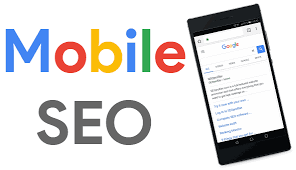
Mobile SEO is the process of designing a mobile-friendly website which is responsive. Mobile SEO is used when your site is being viewed on a mobile device. The screen size and bandwidth of your site changes to match a mobile’s display.
When designing mobile SEO, you need to avoid the following mistakes:
(i) Keep in mind that mobile pages are slow to load. You can use an SEO tool to analyse the speed of your mobile internet.
(ii) Don’t Block CSS and JavaScript. Having CSS and JavaScript inline is critical for mobile sites since they can be downloaded with your content.
(iii) Too many mobile redirects hurt page speed. If you do use multiple links, make sure they all direct to relevant content.
(iv) Use of heavy images increases load time. But, images are essential to your content consumption. Have a balance between images and content.
(v) Use of plugins and pop-ups should be avoided since Java and Flash may not be enabled on mobile devices.
There are three configuration options when optimizing your site for mobile SEO.
(i) Responsive web design
This is the simplest mobile configuration and is recommended by Google. Here, the HTML code is on the same URL but the display size is reduced to fit a mobile screen.
(ii) Dynamic serving
In this configuration type, the URL remains unchanged, but the content offered on a mobile device is different from that of desktop content.
(iii) Separate URL
This involves maintaining two different URLs, one for the desktop site and another for the mobile site.
Some important Mobile SEO Tools are
(i) Google Webmaster Tools.
(ii) Mobile Emulator.
(iii) Moz Local.
(iv) Responsive Web Design Testing Tool.
(v) Screaming Frog.
(vi) User-Agent Switcher.
7. Activities performed by Search Engines
If you plan to do some SEO basics, it is just so that you know how search engines work. Different activities that a search engine performs are:
(A) Crawling
This fetches all the web pages linked to a particular website. Softwares like a crawler, spider, or Googlebot do the crawling.
(B) Indexing
It creates an index for all the fetched web pages and keeps them in a giant database from where data is retrieved. Indexing identifies the words and expressions that describe your page.
(C) Processing
It involves the processing of a search request by comparing the search string in the search request with the indexed pages in the search engine database.
(D) Calculating Relevancy
Since more than one page could contain the same search string, relevancy calculation helps in checking the relevancy of each of the pages. The latest SEO tutorial includes all the necessary information that is required to calculate relevancy.
(E) Retrieving Results
Retrieving the best-matched results is the last search engine activity. This refers to the data that is retrieved based on the keywords entered by the user.
(F) Search Engine Rank
(i) For any keyword search on a search engine, thousands of results may come up. The ranking of your page is measured by the position of your web pages displayed in SERPs (search engine result pages). You can get all the information related to this in the latest SEO Tutorial PDF.
(ii) SEO Tutorial PDF includes lessons on how to optimize search engine rank and lets your pages rank higher in search results.
(iii) From designing and developing an SEO friendly website to ensuring optimized online presence, SEO tutorial PDF includes all the important SEO tips and techniques.
8. On-Page and Off-page SEO
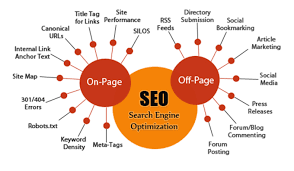
On-page SEO refers to what your website is about while off-page SEO is the popularity of your site. Let’s understand both these concepts in detail.
(A) On-Page SEO
It involves optimizing your content, adding the right keywords at the right places, using relevant keywords, using an apt title for every page, etc. Some on-page optimization practices are adding relevant backlinks, directory submissions, quality content writing, Google Page rank, etc. An on-page SEO tutorial includes the following concepts-
On-page Optimization includes:
(ii) Keyword Research with Google Keyword Planner.
(iii) Select Domain Name
(iv) Using right page title {URL Structuring} and Folder Naming.
(v) Image Naming, Image Title, and ALT Tags Creation.
(vi) Meta Tags like Description, Keywords, Author, Country, Robots, etc.
(vii) Redirection Tags, Headings Tags {H1 to H6}, content writing, Anchor Text, Link Title.
(viii) Robots.txt file use and creation, HTML Sitemap creation, ML Site Map Creation, ROR text sitemap, etc.
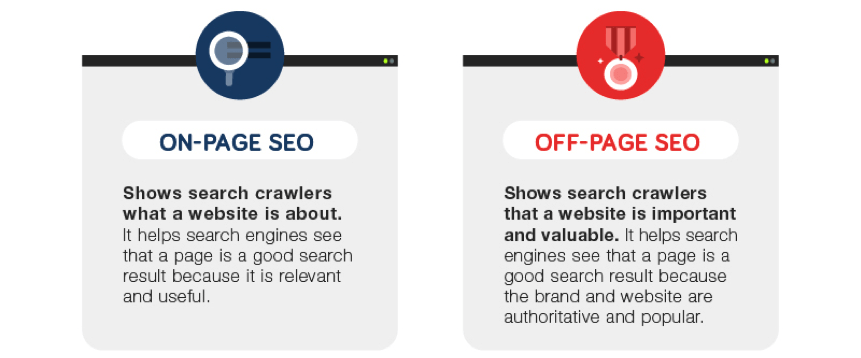
(B) Off-Page SEO
Off-page SEO refers to the external factors that can help improve your page ranking. It depends on link building, social networking, increasing link popularity via submitting content to open directories, doing a link exchange, etc. Different off-page SEO practices include publishing blogs, classifieds posting, forum posting, adding a business listing, social bookmarking, social networking, RSS Feeds, link exchange, etc. A successful off-page SEO includes the following concepts:
(i) Creating content that people want to share.
(ii) Improving social presence to increase interaction with the audience.
(iii) Networking and partnering with influencers to direct more traffic to your website.
(iv) Guest blogging on related sites.
9. Social Media & SEO
Adding off-page links was a great way to increase search ranking initially. But, adding such links can lead to spam nowadays, which prevents websites from using links.
This is where social media comes in. A social media post does the work of a link when users share a post with others. When a post is shared, it gains engagement, which is a primary factory for search engine ranking.
Now, search engines use social signals to determine a website’s social interaction. So, focusing on social media engagement is an important part of any search engine optimization tutorial.
Here are some ways social media can help to optimize SEO.
(i) A quality social media post can help establish website authority. When you put up high-quality posts, it increases your domain value, thus improving website authority.
(ii) Adding backlinks is important to increase search ranking. This will help you attract backlink opportunities, not only from your users but from bloggers and influencers too.
(iii) User is the most important factor in social media sharing. Your posts should focus on your target audience since the search engines look for a human touch when ranking social sharing.
(iv) Optimize your social profile, which can help more people find your brand. When you optimize your posts by adding quality content, it helps people learn more about your brand.
(v) Make sharing on social media easily so that your content reaches more people. You can do this by connecting your content to various social segments, thus improving brand visibility.
(vi) Social media posts get indexed. When you post something relevant and authentic, it gets into a search engine’s pool of social media indexing.
(vii) In any SEO tutorial, keywords are the most important aspect, and social media is no different. Users will initially come across your website through a keyword search and understanding your user’s intent helps you provide them with relevant content.
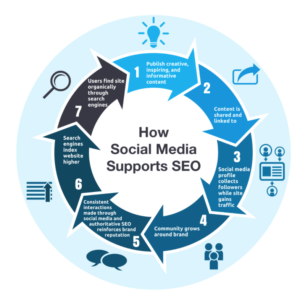
The two important factors for determining a website’s social presence are social reputation and social sharing.
(i) Social Reputation
Only have a social media account is not enough to get a social presence. Your social media posts should be engaging and relative to your product.
Similarly, have multiple social accounts just to create a buzz in not going to help in the long run, since such accounts can be easily filtered out – they will have a handful of friends and only a few posts that will not gain as much viewership.
(ii) Social Shares
The more people share your post on social media, the better it is for your SEO. It will increase your audience and engagement, thus improving your search ranking.
Social sites are a great way to build a network. The popular social sites are Facebook, Twitter, Instagram, and Pinterest.
10. Search Intent
Optimizing your content to match the search intent is what helps rank your website on the first page of the search results. Identifying the search intent for your product can be done through Google’s algorithms.
For example, just the word “cat” cannot get you the result you are looking for. Do you mean to find cat food or are you looking to adopt a cat? But, when you type the word cat in your Google search, it will give you an overview of SERP for your keyword.
Say you input the search term as “cat breeds.” Your result page will look like below.
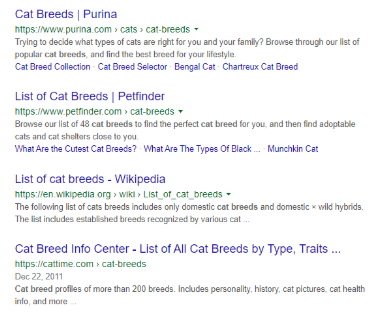
There are various results here from blog posts about different cat breeds to a list of various cat breeds on Wikipedia. Looking at these results doesn’t tell you the search intent.
Using a targeted keyword that garners specific results is the best way to give your user what they are looking for. You need to analyze search intently for the product or service you are offering so that your website can deliver the most relevant content.
11. What is Spam?
An important aspect of an SEO tutorial is understanding how your page is ranked by a search engine. Does the search engine algorithm consider your content as relevant to the users or is it categorized as spam?
As long as your content looks valuable in relation to your product, it is not categorized as spam. And, to ensure you don’t accidentally do something that can put your page in the spam category, you first need to understand the things that can cause your website to be labelled as spam.
According to Google, if a page is out to make money only, it is spam. Here are some of the things that are categorised as spam and should be avoided.
(i) Shallow content
Thin or shallow content that doesn’t have any substance is filtered out by Panda, a domain-level penalty that treats content that is not valuable to the user as spam.
(ii) Cloaking
This refers to hiding your site so that the search engine sees a different version of your site than what a human sees. Search engines consider cloaking a deliberate attempt to manipulate search results, and a cloaked website is immediately banned.
(iii) Keyword stuffing
While any SEO tutorial recommends using only the keywords you want to be found for, too many instances of a keyword are called “keyword stuffing,” and can result in your page ending up in spam.
While there is no limit on the number of times you can use a keyword, using a keyword too many times in a row or using it every other word is keyword stuffing.
(iv) Ad-heavy layout
If your page is so filled with ads that it’s almost impossible to read the content, it is considered irrelevant for the user. When users don’t get what they are looking for from your website, they are going to look elsewhere.
This falls under maintaining user experience, which is what SEO is about.
(v) Paid links
Google has been known to act out against websites that use paid links to attract the audience. According to a New York Times article, J.C. Penny was penalized by Google for using paid links.
To avoid such a scenario, don’t use paid links to increase search engine credits.
12. SEO Copywriting
SEO copywriting is another important part of the latest SEO Tutorial because-
(i) It is an important SEO technique of writing intelligible text on a web page in such a way that it engages the visitors, targets specific search terms, and ensures conversions.
(ii) Purpose of SEO copywriting is to let the content rank high in the search engines for the targeted keywords.
(iii) It optimizes different on-page elements such as title, keywords tags, description, headings, and alternative text.
(iv) It fulfils the requirement of search engines to have genuine content pages that add value in the life of Google users.
13. SEO Guidelines
When it comes to SEO, there are certain guidelines that marketers need to follow regarding content and design for SEO optimization.
These guidelines are an important part of any SEO tutorial, and we have covered all these concepts in detail above.
Here is the gist of all the content and design related points for SEO optimization.
Choosing keywords that are related to your product. Google Keyword Planner and SEMrush are popular keyword analysis tools to help you find the right keywords.
(i) Your content should be unique and should not have any form of plagiarism.
(ii) Keep keyword density in mind. To check keyword density, divide the number of times a keyword is mentioned by the total words in the text and then multiply the result by 100 to get your keyword density.
(iii) When using links, ensure that relevant content is linked. Adding links to something different from the current content will annoy your readers.
(iv) Use short paragraphs and bullet points wherever possible to help the reader absorb your content better. This is especially beneficial when your content is longer than 1000 words, where short paragraphs make it easier to read.
(v) Making mistakes while writing is natural, so make sure to proofread your content before publishing it.
(vi) Place keywords and relevant phrases at the right place, such as in the title, header, meta description, etc. While proper keyword placement is required for every page, it is essential for your home page as well since it is a sort of introduction to the rest of the pages.
(vii) As discussed in User Intent above, the main goal for your site is to make it user-friendly. This means that your website should be easy to navigate so users can move from one step to the next easily. Also, you can add a search box to help users find what they are looking for.
(viii) Optimize your URL so that the search engine can tell exactly what your website is about. The best way to do so is to add your keyword in the URL.
(ix) Images help users visualize your content, which improves their understanding of your content. Images should be placed strategically throughout your content and should have relevant alt tags.
(x) Lastly, simplicity gains more readers. Your design elements should be simple so that they complement your content and not overpower it. And, avoid horizontal scrolls and pop-ups since they tend to annoy readers.
This video tutorial will help you better understand the SEO guidelines to help you achieve your content goals.
14. Latest Google SEO Updates and Algorithm Changes
The SEO updates depend on Google’s algorithm updates. We all know that Google is the pioneer in search marketing, different Google Algorithm Updates play a significant role in the optimization of your website. Taking this thought into consideration, we have come up with this complete SEO tutorial.
Knowing Search Engine Algorithm Basics, going through Working of Search Algorithm and understanding how search engine updates its algorithms guide Search Marketing Professionals channelize their SEO campaigns in the most SEO friendly manner. Different search engine concepts that an SEO professional should learn in-depth are-
(i) Search Engine Penalties and Recoveries.
(ii) Reasons why search engine penalizes a website, etc.
(iii) Google Panda Algorithm, Google Penguin Algorithm, Google EMD Update, etc.
(iv) The saving site from Google Panda, Penguin and EMD Update.
(v) Recovering site your site from Panda, Penguin and EMD.
(vi) All SEO professionals can click here to learn SEO updates in detail.
14. SEO Video Tutorials
In case you want to learn SEO basics in a more interactive and practical manner, then SEO video tutorials are the best fit for you. You can easily find the practical lessons about all the above-mentioned steps in SEO tutorial video. Given below are a few examples of how to master SEO:
How this SEO Tutorial will benefit you
(i) Will ensure effective online brand optimization for your e-business.
(ii) Will help you align your web presence as per the future of Search.
(iii) You will be able to use SEO for visibility, engagement, lead generation, and conversion.
(iv) Will help you understand the role of content in SEO.
(v) Will help you leverage social media for SEO.
(vi) Will help you know the basic SEO tools to improve and automate performance and productivity.
(vii) You will be able to measure the ROI of SEO.
(viii) Will guide you about live instructor-led video sessions that help you understand SEO practically.
(ix) Will help clear SEO certification exams and be a certified SEO expert.
Final Thoughts
The aforementioned steps of this SEO Tutorial will help you learn and implement almost all major concepts related to SEO for new websites. I designed this Search Engine Optimization tutorial to make you be familiar with most frequently used SEO terminologies, SEO practices, Search Algorithms, latest SEO trends, etc.
Once you go through this SEO tutorial, you will learn how to optimize keywords, Meta tags, title, anchor, alt, and other texts that play an essential role in channelizing successful SEO campaigns.
Through this complete SEO tutorial, you will also understand how SEO copywriting helps you have good content on your site. You should also be aware of the elements of SEO infographics for a better understanding of SEO for new websites.
So, this was all about Search Engine Optimization. However, there is another sub-set of Digital Marketing that is extensively used by a majority of marketers which is Pay Per Click. Read this Quora Answer to know the difference between SEO & PPC.
On a concluding note, given below are some other important points for SEO for a new website that I find important to include in this SEO tutorial:
(i) All pages must conform to W3C standards and keyword density should never be abusive.
(ii) You should always include robots.txt, urllist.txt and sitemap.xml.
(iii) Keywords play a very prominent role in the Title, Headings and meta tags.
(iv) ALT tags and Title tags should never be forgotten.
(v) Nomenclature should get indexed.
Want to be an expert in Search Engine Optimization? Join an SEO course having a complete SEO Tutorial and be a certified SEO professional.
If you have any doubts in understanding any of the aforementioned basic SEO steps, please feel free to ask away in the comments section below.











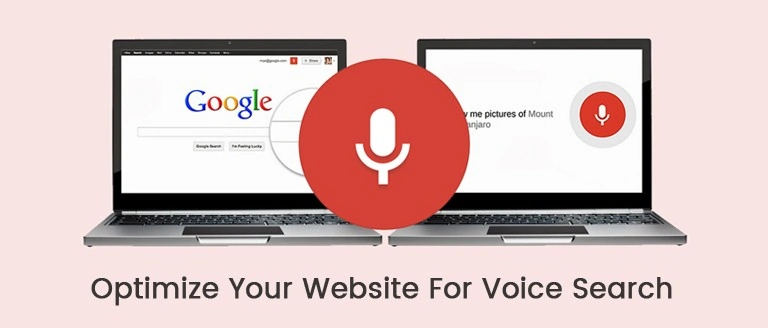







I liked this post, short and to the point. Video is attractive too.
Is there any short tutorial of video of something deeply explaining offpage seo?
Hi Sahil,
I would like to share one our course on SEO where you can learn all SEO Techniques you need to promote your website or to start your career in SEO: https://www.digitalvidya.com/blog/seo-course/
Hope this helps.
I liked this post. It is very helpful for SEO beginners to understand what is SEO and what are the things to do …thank you
Hi Muhammed,
Thanks for appreciating our efforts.
if we want to learn digital marketing then we must learn SEO or search engine optimization.And you are helping the beginner to learn SEO through this blog. Thanks a lot for the very beautiful blog.
Hi Jhunu,
Thanks for the appreciation.
Very Helpful Tutorial
Thanks Maqsood
SEO is the techniques to get legal rank in search engine.
Thanks to Admin to share SEO lessons .
Thanks Brian
This was a super amazing tutorial, in short, I would like you to share more in brief about on page SEO. Thank you!
Hi Atul,
Thanks for the appreciation.
Nice put up here thank you Manish.
Thanks Rahul
very nice. This is a very helpful tutorial.
Thanks Puja
Very nice article
Thanks Krishna
Nice Article, Excellent information in easy language.
Thank You
Thanks Arun
Very good and very helpful post. Thanks for sharing.
Thanks Santosh
thank you for sharing this piece of information it was very helpful.
I am also learning about SEO, I think this post & all the mentioned place will help me a lot. Thanks for sharing.
Great! Thanks for sharing
Awesome! It’s great to start a blog with good SEO right from the start. It will make a lot of difference in the long run!
thank you for sharing this piece of information it was very helpful.